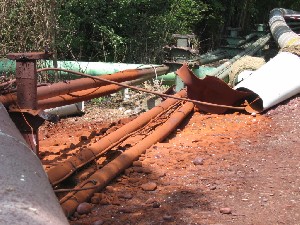A pipeline used to transport gaseous chlorine (Cl2) exploded between a chemical platform (run by the producer) and an elastomer manufacturing site (user).
The pipeline, built in 1961 for the transport of hydrochloric acid (HCl), had been operated since 1986 for transferring deoxygenated and dried Cl2. 200 mm in diameter and 3,600 m long, made of painted steel, heat-insulated and outlined over the upper external part by a heating tube via the skin effect, this pipeline was being operated at 4 bar relative pressure and 30°C. As of the previous day, production had been shut down for a 10-day maintenance period, bringing the pressure inside this chlorine pipeline down to 0.25 bar.
The explosion occurred outside the user’s site 150 m from the delivery point; the pipeline was ruptured in 4 spots and showed traces of internal shock waves over a 70-m length. The explosion produced no victims, despite considerable pipe debris being strewn over a 150-m radius. The quantity of Cl2 emitted into the environment was evaluated at 475 kg. The damage identified (spiral rupture, pressure wave, etc.) characterised the detonation power of the explosion. The physical impacts were significant on the 4 other pipelines (100-mm diameter) of the aboveground rack: 2 nitrogen pipes (13 bar, 2,000-3,000 m³/hr) were deformed, yet remained sealed. Their pressure was brought down to 10 bar, the damaged oxygen pipe (10 bar) had been drained, and the last disused pipe contained nitrogen (N2) at atmospheric pressure.
An H2 / Cl2 explosion caused the accident. The formation of H2 (20%) can be explained by a combination of several elements: accidental introduction of humidity into the pipe during a previous maintenance operation, leading to hydration of the ferric chloride present; a crystalline phase change in the deposit (according to the operator, due to excessive heating of the pipe, i.e. 80° to 90°C) and thus facilitating attack of the steel (by hypochloric acid) as well as H2 formation; heating resulting from a drop in electrical supply of a temperature sensor, following a cable break at the user’s site during inappropriate handling of one of the structure’s protective slabs 3 days prior.
The proportion of hydrogen (20%) released into the gaseous Cl2 contained in the insulated pipeline at each end, under low pressure (0.25 bar), gave rise to an explosive mix that a very small amount of energy could trigger (i.e. roughly 10 micro-Joules would be sufficient for ignition).
The operator cleaned the interior of the structure (2.5 to 3 tonnes of mineral and organic residue were extracted) and made plans to: insert temperature probes every 500 m along the length with both low and high safety levels; revise and secure the electrical layout; and perform regular endoscopic controls.
Download the detailed report in .pdf format (218 Kb)





